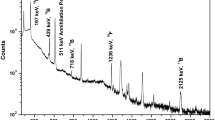Abstract
PIGE was used for isotopes determination in B4C. The distribution profiles of boron and carbon are determined. Boron isotope distribution was studied using nuclear reactions 10B(p,αγ)7Be and 11B(p,γ)12C, while in the best depth resolution was about 400 Å. When studying the istribution of carbon used nuclear reactions 12C(p,γ)13N and 13C(p,γ)14N with the best resolution equal to 470 Å. Such possibilities PIGE used for development process CVD and produce of boron carbide with need characteristic.




Similar content being viewed by others
References
Bokuchava GV, Karumidze GC, Korzh AF, Shirokov BM (2008) Termoelectricheskie svostva karbida bora, poluchennogo rasnymi metodami (in Rassian). Aviatcionnaya kosmicheskaya technika i technolodiya 2(49):60–64
Albert B, Werheit H, Jung W, Hofmann K (2006) Boron, borides, and related compounds: proceedings of the 15th international symposium on boron, borides, and related compounds (ISBB 05). J Solid State Chem 179(9):2746
Nishi Y, Arita Y, Matsui T, Nagasaki T (2002) Isotope effects on thermal conductivity of boron carbide. J Nucl Sci Technol 39:391–394
Takasaki I, Nagumo T, Inaba T, Yoshino N, Maruyama T (2012) Measurement of the isotopic abundance of boron-10 by inductively coupled plasma-quadrupole mass spectrometry. J Nucl Sci Technol 49:867–872
Patelli A, Rigato V, Salmaso G, Carvalho NJM, De Hosson JTM, Bontempi E, Depero LE (2006) Ion bombardment effects on nucleation of sputtered Mo nano-crystas in Mo/B4C/Si multilayers. Surf Coat Technol 201:143
Kapustin VL, Semenov NA, Khovansky NA, Shirokov BM (2004) Obtaining of boron carbide by hydrogen reduction of three-chloride boron in toluene vapors. PAST Ser Nucl Phys Investig 1:105–107
Bondarenko V, Glazunov L, Goncharov O, Zats A, Kuzmenko V, Levenets V, Omelnik O, Pistryak V, Suphostavets V, Stchur O, Usikov N (2006) Analytical nuclear physical complex SOKOL. Current problems in nuclear physics and atomic energy. Kyiv Proc 7 p: 852–857
Acharya R, Raja SW, Chhillar S, Gupta J, Sonber JK, Ch Murthy TSR, SasiBhushan K, Rao Radhika M, Majumdar S, Pujari PK (2018) Non-destructive quantification of total boron and its isotopic composition in boron based refractory materials by PIGE and inter-comparison study using TIMS and titrimetry. J Anal At Spectrom 33:784–791
Zeps VJ, Adelberger EG, Garcia A et al (1995) Parity mixing of the 0+-0- I=1 doublet in N-14. Phys Rev C51:1494–1520
Kopecky J, Sublet JC, Simpson JA, Forrest RA, Nierop D (2010) Atlas of neutron capture cross sections. NGAtlas/ZV (iaea.org)
https://www.nuclear-power.net/nuclear-power-plant/controlrods/
Wood C, Emin D, Gray PE (1985) Thermal conductivity of boron carbides. Phys Rev B31:6811–6817
Jon-L I, Portehault D, Gouget G, Maruyama S, Ohkubo I, Mori T (2017) Thermoelectric properties of boron carbide/HfB2 composites. Mater Renew Sustain Energy 6:6
Mestvirishvili Z, Bairamashvili I, Kvatchadze V, Rekhviashvili N (2015) Thermal and mechanical properties of B4C–ZrB2 ceramic composite. J Mater Sci Eng B 5:385–393
Nagamatsu J, Nakagama N, Muragama T, Zenitani Y, Akimitsu J (2001) Superconductivity at 39 K in MgB2. Nature 410:63–69
Silvester B, Lin S-H, Feldman BJ (1995) Doping vs alloying in amorphous hydrogenated boron carbide. Solid State Commun 1995:969–971
Elvert M, Suess E, Greinert J, Whiticar MJ (2000) Archaea mediating anaerobic methane oxidation in deep-sea sediments at cold seeps of the eastern Aleutian subduction zone. Org Geochem 31:1175–1187
Claypool GE, Threlkeld CN, Mankiewicz PN, Arhtur MA, Anderson TF (1995) Isotopic composition of interstitial fluids and origin of metane in slope sediment of the middle America trench, deep sea drilling project LEG 84. Initial reports of the deep sea drilling project. 84:683–691
Amsel G, Lanford WA (1984) Nuclear reaction techniques in materials analysis. Annu Rev Nucl Part Sci 34:435–460
Funding
Funding was provided by National Academy of Sciences of Ukraine.
Author information
Authors and Affiliations
Corresponding author
Additional information
Publisher's Note
Springer Nature remains neutral with regard to jurisdictional claims in published maps and institutional affiliations.
Rights and permissions
About this article
Cite this article
Levenets, V., Omelnyk, O., Shchur, A. et al. Possibilities and analytical aspects of the PIGE method for the study of B4C. J Radioanal Nucl Chem 329, 1183–1189 (2021). https://doi.org/10.1007/s10967-021-07873-y
Received:
Accepted:
Published:
Issue Date:
DOI: https://doi.org/10.1007/s10967-021-07873-y




